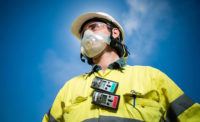Electronics create smart product innovations in respirators

The PPE market has certainly changed over the years. There is a long history of personal protection from animal parts and hides to sophisticated materials and designs used today. The role of PPE in America’s workforce has continued to expand, improve and drives positive results.
Respirator developments
Respiratory protection has evolved over the years. When OSHA arrived in the early 1970s, employers took a more critical and proactive role protecting workers. What types of respirators do employers select today to properly protect workers? Respiratory protection has two main categories:
Air Purifying – APR dust mist protection and gas and vapor protection; most commonly disposables or air purifying cartridge respirators.
Air Supplying - PAPR – powered air purifying respirators; supplied air – continuous flow respirators; self-contained breathing apparatus for IDLH and super-heated environments.
The most popular, accessible, lowest price point and most utilized protection are APRs with disposables leading the way. They are simple and many employers don't know how or want to deal with a respirator program. Disposable APRs “appear” to be the easy and cost effective option. But without a well-managed respirator program and effective employee training disposables can “go like candy at recess,” provide inadequate protection and become an unruly and expensive cost.
Today’s market
Filter media have improved and plastics and other materials for face pieces have evolved but we haven’t really seen anything ground-breaking. In the past ten years or so, acquisitions and consolidation have limited the well-known brands to a few household names. And innovation is hard, right? Respirators are technically complex PPE governed by OSHA standards and NIOSH certifications that require manufacturers to design, test and pass stringent requirements. The market for PPE has concentrated around a few large manufacturers and low price/high volume commodity players.
Interestingly, with the world becoming so-called “flat” with immediate access to a worldwide marketplace through the internet, Alibaba, and other search functions it’s very easy for the any PPE company or start up to find a foreign factory with experience getting NIOSH approvals who will quickly and easily private label a N95 or other APR. There are many new brands or labels on the market but most are extremely similar and meet the same NIOSH standard for OSHA compliance.
Is the ability for a new product and brand to enter the marketplace a good thing? Time will tell if these choices bring better worker acceptance, better protection, the ability for more workplaces to become compliant with regulations, and drive costs down. There are certainly potential risks dealing with smaller companies/brands but the marketplace will decide if they are of value.
International respiratory and PPE options seem to fare a bit better. In many parts of Europe and the UK regulatory enforcement is increasing, as is worker awareness of the need for protection. This has driven enhancements to respiratory protection, with some manufacturers developing respirators built-in or designed to more closely work in conjunction with other PPE. Full face respirators are much more accepted and as PAPRs become more cost-effective, employers gravitate toward the ease of use and higher protection factors of PAPRs, according to a 2016 Frost and Sullivan report. PAPRs have long been expensive belt-mounted products with a heavy motor and filter system with bulky tubes that affects worker acceptance.
What should we be looking for in respiratory protection in 2017? An update on an old model, or technologies and materials to improve design, weight, feel and comfort? Electronic solutions that create responsive and smart respirators?
Why shouldn’t the PPE marketplace innovate like the technology we use in our everyday life? The American worker deserves the best in workplace safety, technology and innovation. Watch for coming advancements. It’s about time.
Looking for a reprint of this article?
From high-res PDFs to custom plaques, order your copy today!




